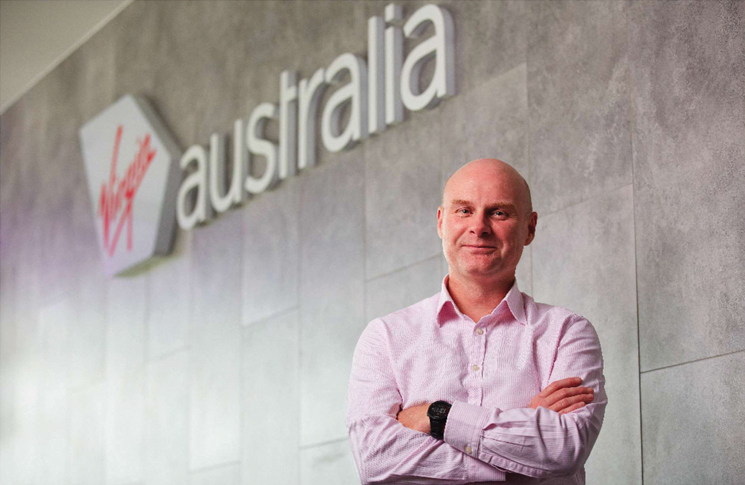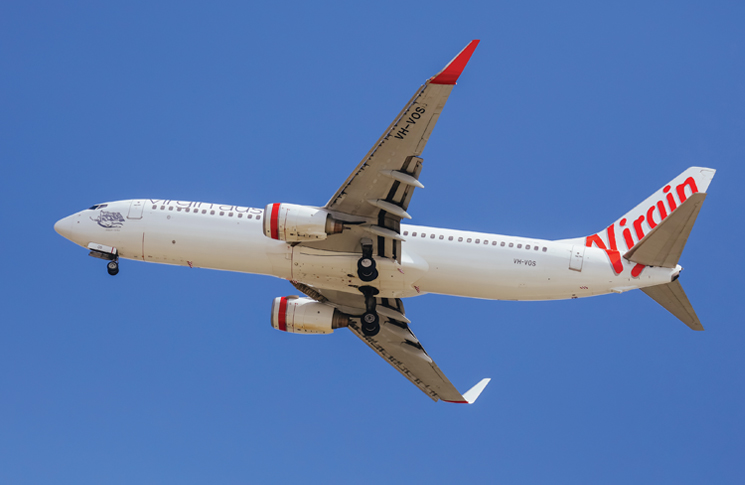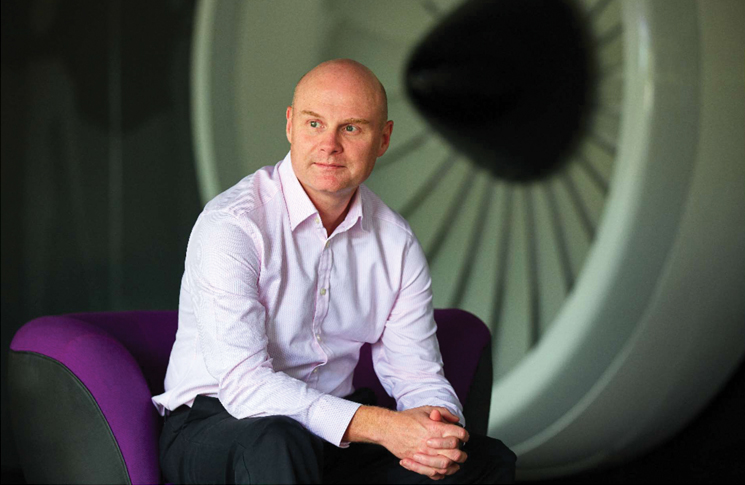Stuart Aggs, Virgin Australia Group Chief Operations Officer, is a firm believer in delegating authority to those with the responsibility for safety.
Ultimately, the buck stops with him, but trust is the underlying theme of his style of safety leadership. Last year he was appointed to CASA’s Aviation Safety Advisory Panel, which was formed in 2017 as the primary advisory body through which CASA directs its engagement with industry. Virgin Australia has emerged from receivership with a smaller fleet and workforce. However, despite the lockdowns due to the pandemic, it has increased its fleet of Boeing 737s this year as it seeks to cement its place in the hotly contested domestic aviation industry. As well, the airline is not allowing the pandemic to affect its strong commitment to a safety ethos.
You studied psychology at university – how has that served you in your career?
I think it has allowed me to reflect on some of the key factors of safety, particularly on the organisational side. For instance, how do a group of individuals inside an organisation operate? What are the key behavioural psychology elements that we all display and use, to better our performance?
So having this degree has helped me understand what motivates individuals in certain circumstances, but equally, at an organisational level, what are the things the organisation must provide in terms of structures and processes that allow people to do the best job they can and support them in the workplace.
After university, your first job at Hazelton Airlines was manager of regulatory affairs and compliance – but that title contained no mention of people, culture or safety?
I’d flown GA for a while before I went to Hazelton but, as you mentioned, my job there was a compliance-based one. The view back then – and one I shared – was that compliance equals safety. So my role was to make sure we had a compliance statement and supporting processes and these were up-to-date. The view then was that if we were compliant, then we had met all the essential requirements and that was the key focus, so we went through a whole lot of work and we got the manuals, checklists, etc., up to date.
This net result was that CASA at the time was satisfied as we had demonstrated compliance. Of course, this was well before SMS [safety management system] had come into its fore and, as a result, well before we all understood the difference between compliance and system safety.
So compliance is a necessary condition but not a sufficient one?
From our perspective now, it’s just another risk control; however, it is a very basic one. Do we have all the manuals and procedures covering off what our basic regulatory requirements are? Yes, we do – tick – then we move a long way from there. The work then becomes how to ensure, as an organisation evolves and changes, these criteria and understood, managed and reviewed, but in itself, this is only a small component to system safety.
How do you define safety leadership?
Probably the most important thing from an airline perspective in my mind – and this is coming from someone who went into a safety role at a time when safety outcomes were seen to be owned by the safety people – is that safety leadership, or safety ownership is probably a better phrase, inside an airline or any aviation context, is owned by the people who have line accountability for the outcome.
It’s not owned by the people who simply provide a report or run a risk management framework or provide a system from an SMS perspective that helps articulate risks and issues. It’s got to be owned by the people who have the responsibility and that is a fundamental shift – certainly in my career.
Safety leadership is no different to any other form of leadership. It is always about doing the right thing and being seen to do this. These fundamental safety behaviours take discipline – and in my experience – will be challenged. I am aware of circumstances, for example, where people have signed off on safety policies and procedures without reading them.
People seem to think the SMS lives in cupboard and you come in every morning and let it out of the cupboard and it protects everyone.
And I’ve had many conversations where people seem to think the SMS lives in cupboard and you come in every morning and let it out of the cupboard and it protects everyone. This is simply not the case. An SMS is about the people who operate within it and the behaviours they display every day that determine the overall outcomes; this is where a safety culture develops.
A critical point around safety – and it’s something that anyone who is a pilot, engineer or cabin crew member, is instilled in you on day one – is that the safety accountability rests with you as the line operator, the responsibility doesn’t rest somewhere else, it rests with you.
At an organisational level, I am accountable for the safety and operational performance of the airline. To do that though, I must delegate accountability for the safety outcomes and trust the teams below me to discharge their responsibilities in a diligent and professional manner. They do this within the systems we have developed.
You have no magical powers?
No, I don’t and trying to overlay those magical powers, as you put it, only creates organisational friction.
In my experience, there was a bit of friction between what the safety team was trying to achieve and what the line people were trying to achieve and it was only solved when those accountabilities were clarified – it took all the stress away.

What’s the key element of your role?
Here, we trust our people to get the job done and it’s our job – in fact it’s my job as COO – to make sure they have the equipment and the tools to do that and then try to stay out of the way and make it as unencumbered as possible for them to do their jobs.
I’m sure some people laugh at me for saying that but that is my absolute intent. If an organisation doesn’t provide a high trust culture, you won’t get a high reliability culture, because people won’t feel they can be accountable and make decisions and exercise their authority appropriately, so trust has to underpin all of those things.
Does that mean you’re not going to get pride in the work and the organisation without trust?
No, you won’t, that’s dead right, trust relates to that. I think if an employee feels valued and trusted, their view on the organisation will be far more open and they’ll feel far more engaged with the business.
In my experience, organisations that don’t trust their people don’t have good engagement with them and they struggle to get the workforce to engage in the right areas at the right time. So I absolutely agree, it is all related, but equally I don’t think you can have confidence in a leadership structure if there isn’t trust there.
We trust employees to get out every day and do the right thing and complete the work and do it safely and on time, so trust is a two-way street and it relies on consistent behaviours. If you think about what you see when you think you’re looking at a good leader, you are looking really at their behaviour, in particular you’re looking at them both when they are in public and in private. Do they do the same things when they’re not being watched as they do when they’re being watched?
That is a critical factor. Front line team members often look for those cues and they check for those behaviours and they look for that consistency. And you only ever get one chance to get it wrong – then they assume that that’s what you do all the time.
It takes a great deal of commitment to continue to lead the right way and that is part of the challenge, that you’ve got to be prepared to walk and talk it.
You have to delegate a certain amount of control?
You can’t have accountability without authority, it’s very simple.
If you can trust someone to be accountable, for a maintenance task for example, then you’ve got to give them the authority to request the right to manage man hours to complete it appropriately. You’ve got to think all those things through and fundamentally it comes down to trust and trust is probably in my mind the most important trait that an organisation can foster because it unlocks a whole lot of good organisational behaviours around leadership generally that has long-term benefits.
Trust is probably in my mind the most important trait that an organisation can foster.
As a management team we also conduct active monitoring of the safety system and use data analysis on key safety performance indicators to assess whether we are comfortable with our performance.

Your current job title doesn’t include safety but that’s obviously still a big part of it?
Yes, it is – from a CASA perspective, I’m the accountable person for the AOC [Air Operator’s Certificate] under the Civil Aviation Act, that stops with me. I’m accountable for ensuring the safety management system is fully functioning and ultimately, I’m accountable to make sure the accountable managers are doing their job. That is, making sure they are on top of their safety performance and understand the risks and issues in their business units.
That is the focus of our monthly executive safety meeting – those people report to me on what they know about their business from a safety and risk perspective and then we talk through what we need to do, to either make an adjustment here or there or whether there’s more exploration that needs to happen on a particular topic. If there has been an actual incident that’s being investigated, we talk through it in great detail.
Fundamentally my job is an assurance role, to make sure that those people who are accountable for safety are doing the right thing and we have independent data that supports our views on this.
You were a member of an IATA safety group – what was that like as a learning experience?
I was on that group for about five years [2011–2015] and it was one of the best professional experiences I’ve had. It involved talking to the heads of safety of many of the largest airlines around the world.
It was during a period of time that SMS was regulated in some countries but not in others – the US was an example at the time where it wasn’t regulated – and we were also beginning to grapple with things like FRMS [fatigue risk management system] and where does that fit into the SMS and how does an organisation deal with that. FRMS, in my experience, has been the flashpoint where you see the real challenge around funding of safety and whether an organisation has the wherewithal to provide funding for a safety outcome. That’s why FRMS can be so controversial and why many operators struggle with it – they see it only from a cost perspective, they don’t see it from the potential efficiency perspective as we do. It is also a key challenge from a risk perspective. An FRMS tries to mitigate a risk profile that can only ever be estimated through indicative modelling. The real understanding of the actual risk is only experienced subjectively by an individual. This is why organisational controls often struggle to manage the individualised risk.
Do you enjoy your job or does it keep you awake at night?
Not many things keep me awake at night. I am very confident in the ability of our team to deliver a safe and reliable operation and deal with the inevitable changes along the way. That has certainly been our experience over the last 18 months and I suspect we have a few more to go.
I do enjoy my job – I’ve been in operations for a long time and we take a great deal of pride in getting things done, even when the hardest conditions are thrown at us and I’m always incredibly impressed by the way our people go about it.



Comments are closed.